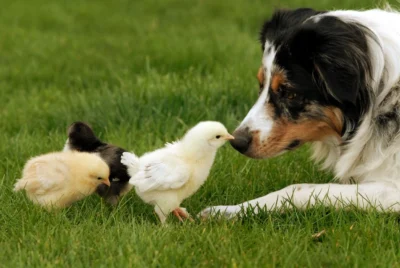How Long Do Roosters Live? (Factors Affecting)
For many poultry enthusiasts and farmers alike, understanding the lifespan of their feathered friends is crucial. Whether you’re introducing a rooster to your flock, considering it as a pet, or simply curious about the poultry world, a common question often arises: “How long do roosters live?”
This question isn’t just a matter of trivia; it touches on broader issues like flock management, attachment, and even the economic implications of raising poultry. The lifespan of a rooster can impact planning, breeding decisions, and emotional preparedness for poultry keepers. So, delve deeper with me as we explore this often-overlooked yet essential aspect of rooster care.
How Long Do Roosters Live?
Roosters typically live between 5 and 8 years, but some can live up to 15 or even 20 years under ideal conditions. Like any living creature, a rooster’s lifespan varies depending on breed, environment, and care.
Whether a bantam rooster strolling around a backyard flock or a Rhode Island Red rooster ruling the roost, rooster life expectancy differs among breeds and individual birds.
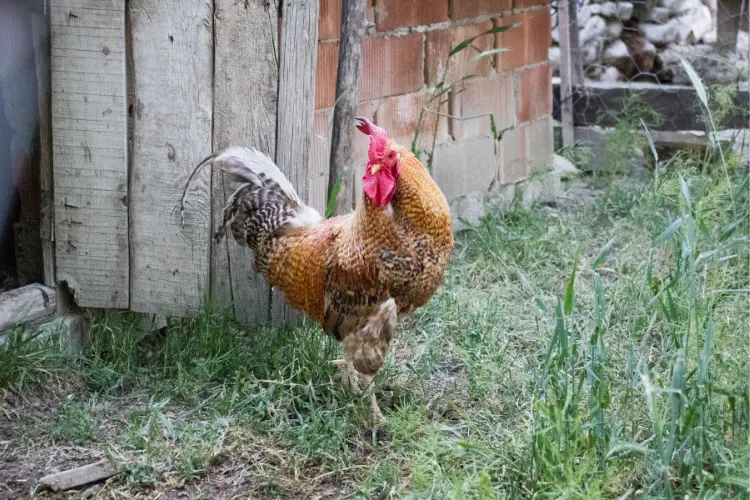
Rooster Lifespan Factors
Genetics and Breed
The genetic composition and chicken breed of a rooster play a significant role in determining its lifespan.
Heritage breeds, which adhere to the standards established by the American Poultry Association, generally have longer lifespans than hybrid breeds. Hybrid breeds, such as the Speckledy, are bred for high production of either meat or eggs, but this often comes at the cost of their life expectancy.
Genetic factors can be associated with longer or shorter lifespans in roosters. Although the exact genetic mechanisms impacting rooster lifespan are under ongoing research, genetics undeniably play a pivotal role in a rooster’s longevity.
This applies not only to mature roosters but also to young chickens, as certain genetic traits may already be present and influencing their life expectancy from an early age.
Environment and Living Conditions
A rooster’s environment and living conditions have a substantial impact on its lifespan. Their well-being hinges on a safe, clean, and spacious environment. Roosters confined to enclosed spaces like a chicken coop experience a decreased quality of life and are more prone to illness.
Ensuring proper temperature and humidity levels, as well as protection from predators, can contribute to a longer and healthier life for your rooster.
Extreme weather conditions can also affect a rooster’s comfort and well-being. For example:
- In excessively hot weather, roosters should have adequate hydration to avoid heat stroke or exhaustion.
- Contrary to the popular belief that roosters only crow at sunrise, they can actually crow at any time of the day.
- Establishing thick hedges or shrubs can help protect roosters from predators, especially when kept with egg layers.
Diet and Nutrition
A balanced diet significantly influences Rooster’s health and longevity. A proper diet should consist of a mix of proteins, grains, seeds, and minerals, as well as access to fresh water. Roosters are omnivorous, consuming small insects, reptiles, and even smaller birds, along with grass, grains, and vegetables.
The type of food a rooster consumes can impact its lifespan, especially when kept in an enclosed area. Feeding roosters solely on layer’s ration can significantly reduce their lifespan, as they require higher protein and less calcium than laying hens.
Read also: What Do Chickens Eat – 201 things on our list

Health and Disease Prevention
Frequent health checks, vaccinations, and appropriate care are indispensable in disease prevention and lifespan extension of a rooster. Health and disease prevention measures include:
- Selective breeding of chickens with demonstrated immunity to diseases
- Vaccination and deworming of the flock as necessary
- Maintaining a clean and healthy environment
In addition to these preventative measures, it’s important to be able to recognize the signs of illness in a rooster, such as:
- lethargy
- anorexia
- depression
- emaciation
- lameness in a single limb
Promptly addressing any health concerns can greatly improve a rooster’s chances of recovery and lead to a longer, healthier life.
Domestic vs. Wild Roosters
While domestic roosters tend to live longer than their wild counterparts, there is still a significant difference in life expectancy between the two.
Wild roosters typically have a maximum life expectancy of two to four years due to factors such as predators and harsher environmental conditions. Domestic roosters, on the other hand, can live up to 10 years or even longer in some circumstances.
Enhancing a domestic rooster’s longevity requires proper care encompassing nutrition, health monitoring, and disease prevention.
Domesticated roosters raised in backyard settings often experience a less stressful lifestyle, leading to a longer lifespan of 5 to 10 years. Their longevity can also benefit from appropriate socialization, exercise, and mental stimulation.
Heritage vs. Hybrid Breeds
Heritage breeds of roosters are those which adhere to the standards established by the American Poultry Association, whereas hybrid breeds are the consequence of mating heritage breeds and are typically bred for their high production of either meat or eggs.
Some examples of hybrid breeds of roosters include the Speckledy, which is a cross between a Rhode Island Red rooster and a Marans hen. The average lifespan of these hybrid breeds, often considered as an average rooster, can vary. However, they are typically genetically diverse and robust, contributing to a longer lifespan of approximately 8 years.
Heritage breeds, on the other hand, often have a longer lifespan due to their adherence to the American Poultry Association’s guidelines and focus on preserving traditional breed characteristics.
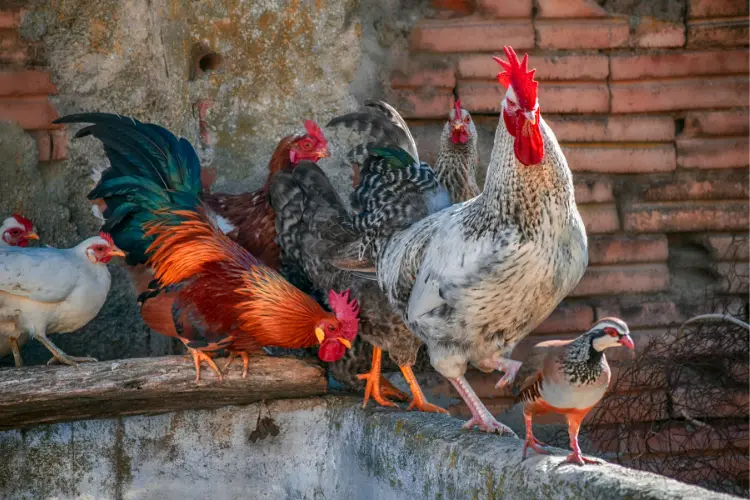
Signs of Aging in Roosters
Feathers
Feather color and quality can change as a rooster ages. Here are some indicators of a rooster’s age:
- Young roosters generally display feathers with a glossy sheen and vibrant colors.
- Older roosters may have faded or duller feathers.
- The emergence of pointed hackle and saddle feathers can indicate a rooster’s age.
- Alterations in growth patterns and the manifestation of rounded wing and tail feathers can also provide clues about a rooster’s age.
Not all rooster breeds experience the same alterations in their plumage as they age. Some breeds may experience modifications in coloration, while others may have dissimilar feather growth patterns.
In addition, certain breeds may possess particular feather characteristics that can assist in distinguishing them as roosters at a juvenile age.
Spurs and Legs
Spurs are a notable feature of a rooster’s legs and can be used to estimate their age. As a rooster matures, its spurs lengthen, curve, and acquire a sharp, pointed tip. The curvature of a mature rooster’s spurs is more pronounced than when they are young.
In addition to the growth of spurs, the appearance of a rooster’s legs can change as it ages. As a rooster ages, its legs and feet may become thicker. Furthermore, leg strength tends to diminish with advancing age, which may cause older chickens to experience difficulty in standing or maintaining balance.
Comb and Wattles
The comb and wattle are fleshy growths located on a rooster’s head and serve as a means of attraction for potential mates and assist in regulating the body temperature of the rooster. As a rooster matures, its comb and wattle can become droopy, and paleness could indicate deteriorating health.
The degree of droopiness of a rooster’s comb indicates its age. Therefore, observing the appearance of a rooster’s comb and wattle can provide a rough estimate of its age, although this method is not foolproof. Nevertheless, it offers a useful starting point in determining the age of a rooster.
Read also: Why Does the Rooster Crow in the Morning?
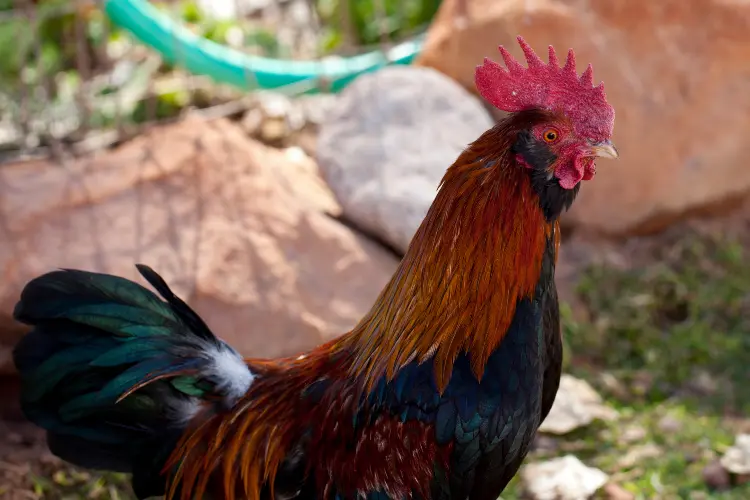
Caring for Your Rooster
Providing your rooster with proper care is key to promoting its long and healthy life. Providing a suitable environment, a balanced diet, regular health checks, and social interaction are all essential aspects of caring for your rooster. Their well-being rests heavily on a warm, dry, and well-ventilated habitat with plenty of roosting room and access to food and water.
Rooster’s health and longevity heavily depend on a balanced diet rich in proteins, grains, seeds, and minerals, as well as access to fresh water. Be vigilant for signs of illness, such as lethargy, anorexia, depression, emaciation, or lameness in a single limb, and address any health concerns promptly.
Their longevity can also benefit from appropriate socialization, exercise, and mental stimulation, all contributing to a healthy and productive life.
Common Rooster Myths Debunked
There are some myths surrounding roosters that have persisted over time, despite evidence to the contrary. For example, the belief that hens require a rooster to lay eggs is a common misconception. In reality, hens will lay eggs regardless of whether a rooster is present.
Another prevalent myth is that roosters crow only in the morning. Roosters can crow at any time of the day, and their vocalizations are not limited to the early morning hours.
Finally, it’s often believed that roosters are inherently mean and aggressive. While some roosters may display aggressive tendencies, this is not a trait that is characteristic of all roosters.
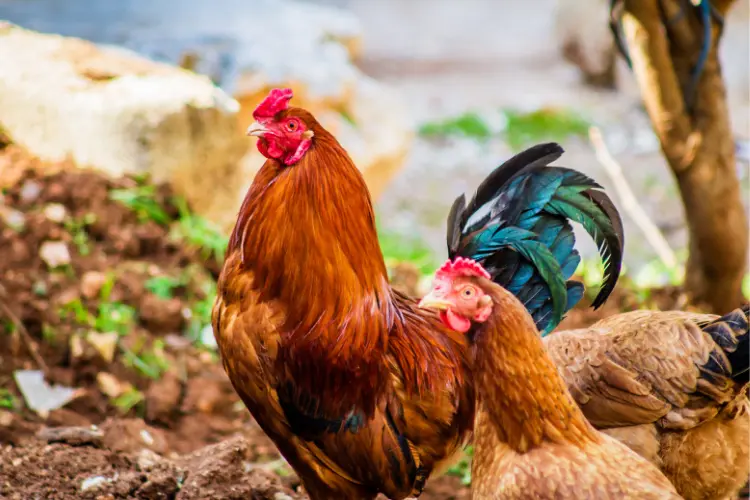
Longest-Living Rooster Records
While most roosters live between 5 and 8 years, some exceptional individuals have reached impressive ages. The world’s oldest recorded rooster, Bob Ross, lived up to 20 years. Another exceptional case is Matilda, a Red Pyle chicken, who had a lifespan of 16 years.
The oldest chicken, a hen named Muffy, lived to be an astonishing 22 years old. These incredible records testify to the potential longevity of roosters and chickens, provided they receive proper care and live in a suitable environment.
Frequently Asked Questions
How Can You Tell How Old A Rooster Is?
The age of a rooster can be determined by measuring the length of its spurs – if they are 3/4 inch or less before December 1, the rooster is likely to be one year old; otherwise, it is likely to be older. Additionally, the Bill Weight test can be used to determine the age of a rooster.
Do Roosters Make Good Pets?
Chickens and roosters are social, intelligent, affectionate, and empathetic, making them good pet candidates. Therefore, roosters can make good pets.
Do Roosters Calm Down With Age?
Generally, roosters will become more docile as they reach six months of age, suggesting they calm down with age.
Wrapping Up
Roosters are fascinating creatures with a life expectancy varying greatly depending on breed, environment, and care. By understanding the factors contributing to a rooster’s lifespan and debunking common myths, chicken keepers can ensure their roosters have the longest and healthiest lives possible.
So, as you tend to your backyard flock and marvel at the vibrant personalities of your feathered friends, remember that with proper care and attention, your roosters can live a long and fulfilling life.


